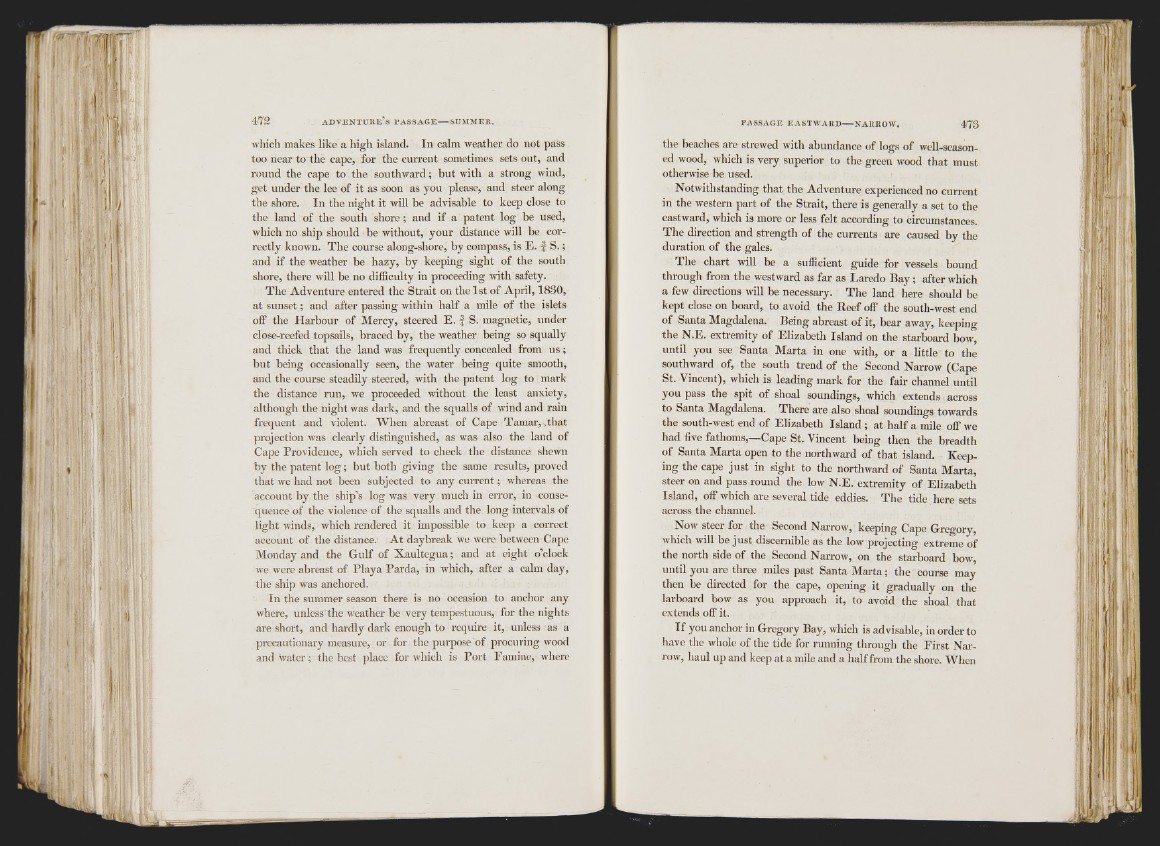
i I
; * '
sa; ■ ■■.
ADVENTURE S TASSAGE— SUMMER.
which makes like a high island. In calm weather do not pass
too near to the cape, for the current sometimes sets out, and
round the cape to the southward; but with a strong wind,
get under the lee of it as soon as you please, and steer along
the shore. In the night it will be advisable to keep close to
the land of the south shore; and if a patent log he used,
which no ship should be without, your distance will be correctly
known. The course along-shore, by compass, is E. f S .;
and if the weather he hazy, by keeping sight of the south
shore, there will be no difficulty in proceeding with safety.
The Adventure entered the Strait on the 1st of April, 1830,
at sunset; and after passing within half a mile of the islets
off the Harbour of Mercy, steered E. f S. magnetic, under
close-reefed topsails, braced by, the weather being so squally
and thick that the land was frequently concealed from u s ;
but being occasionally seen, the water being quite smooth,
and the course steadily steered, with the patent log to mark
the distance run, we proceeded without the least anxiety,
although the night was dark, and the squalls of wind and rain
frequent and violent. When abreast of Cape Tamar, .that
projection was clearly distinguished, as was also the land of
Cape Providence, which served to check the distance shewn
by the patent lo g ; but both giving the same results, proved
that we had not been subjected to any cuiTent; whereas the
account by the ship’s log was very much in error, in consequence
of the violence of the squalls and the long intervals of
light winds, which rendered it impossible to keep a correct
account of the distance. At daybreak we were between Cape
Monday and the Gulf of Xaultegua; and at eight o’clock
we were ahreast of Playa Parda, in which, after a calm day,
the ship was anchored.
In the summer season there is no occasion to anchor any
where, unless the weather be very tempestuous, for the nights
are short, and hardly dark enough to require it, unless as a
precautionary measure, or for the purpose of procuring wood
and water; the best place for which is Port Famine, where
the beaches are strewed with abundance of logs of well-seasoned
wood, which is very superior to the green wood that must
otherwise be used.
Notwithstanding that the Adventure experienced no current
in the western part of the Strait, there is generally a set to the
eastward, which is more or less felt according to circumstances.
The direction and strength of the currents are caused by the
duration of the gales.
The chart will be a sufficient guide for vessels bound
through from the westward as far as Laredo Bay ; after which
a few directions will be necessary. The land here should be
kept close on board, to avoid the Reef off the south-west end
of Santa Magdalena. Being abreast of it, bear away, keeping
the N.E. extremity of Elizabeth Island on the starboard bow,
until you see Santa Marta in one with, or a little to the
southward of, the south trend of the Second Narrow (Cape
St. Vincent), which is leading mark for the fair channel until
you pass the spit of shoal soundings, which extends across
to Santa Magdalena. There are also shoal soundings towards
the south-west end of Elizabeth Island; at half a mile off we
had five fathoms,—Cape St. Vincent being then the breadth
of Santa Marta open to the northward of that island. Keeping
the cape just in sight to the northward of Santa Marta,
steer on and pass round the low N.E. extremity of Elizabeth
Island, otf which are several tide eddies. The tide here sets
across the channel.
Now steer for the Second Narrow, keeping Cape Gregory,
which will be just discernible as the low projecting extreme of
the north side of the Second Narrow, on the starboard bow,
until you are three miles past Santa Marta; the course may
then be directed for the cape, opening it gradually on the
larboard bow as you approach it, to avoid the shoal that
extends off it.
I f you anchor in Gregory Bay, which is advisable, in order to
have the whole of the tide for running through the First Narrow,
haul up and keep at a mile and a half from the shore. When